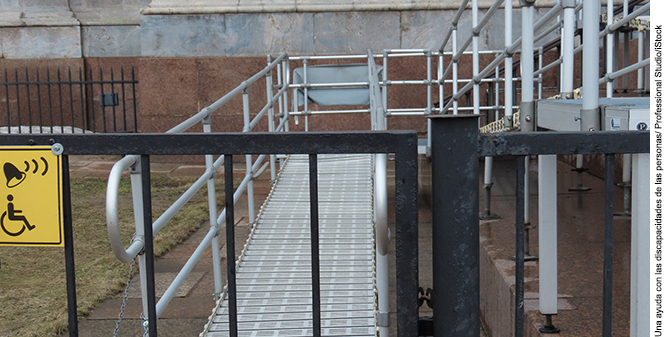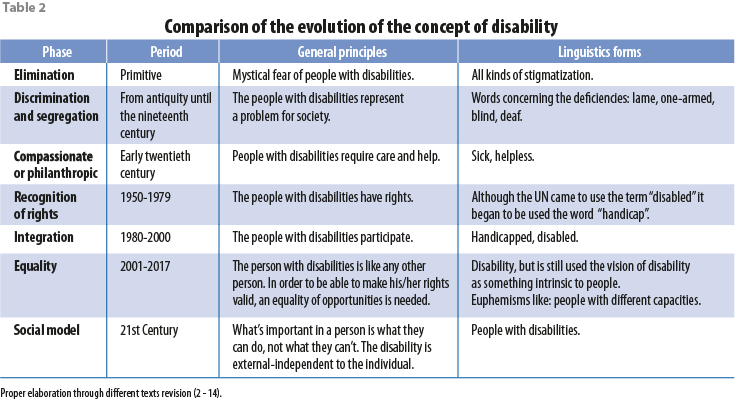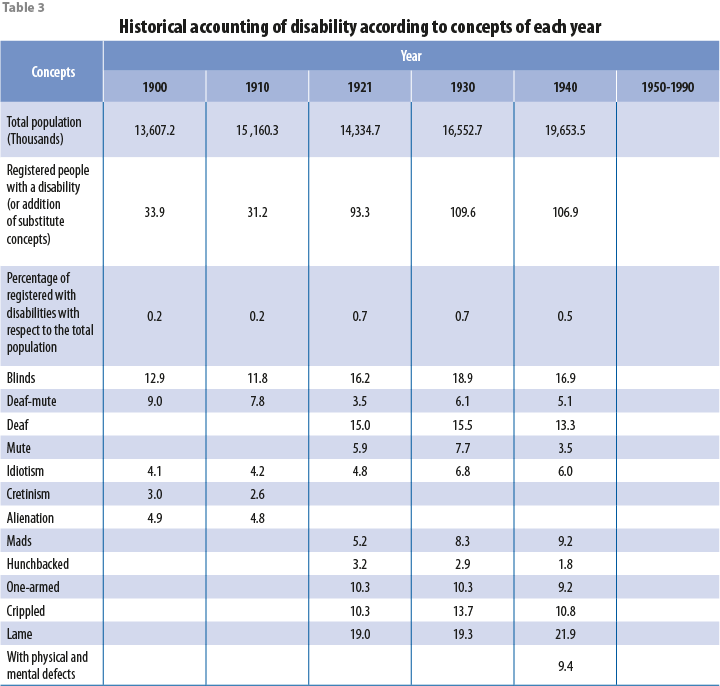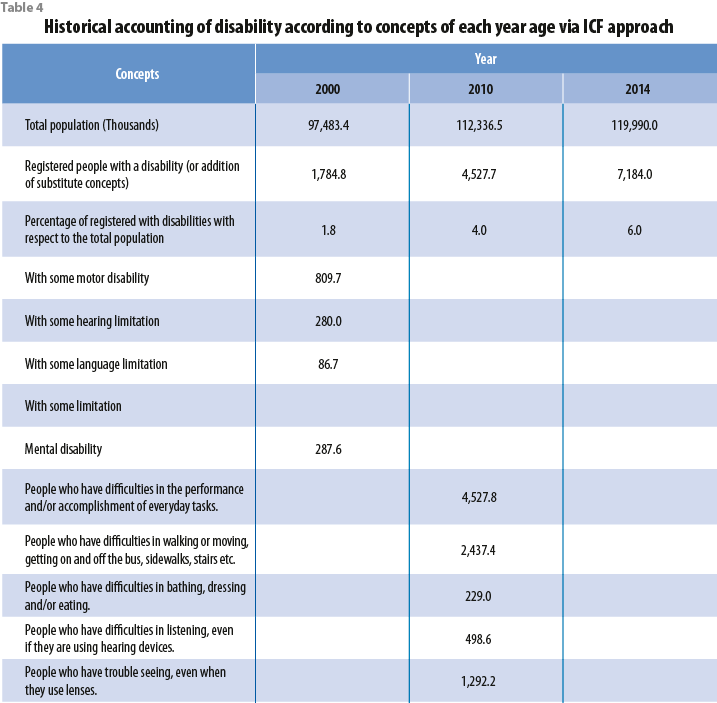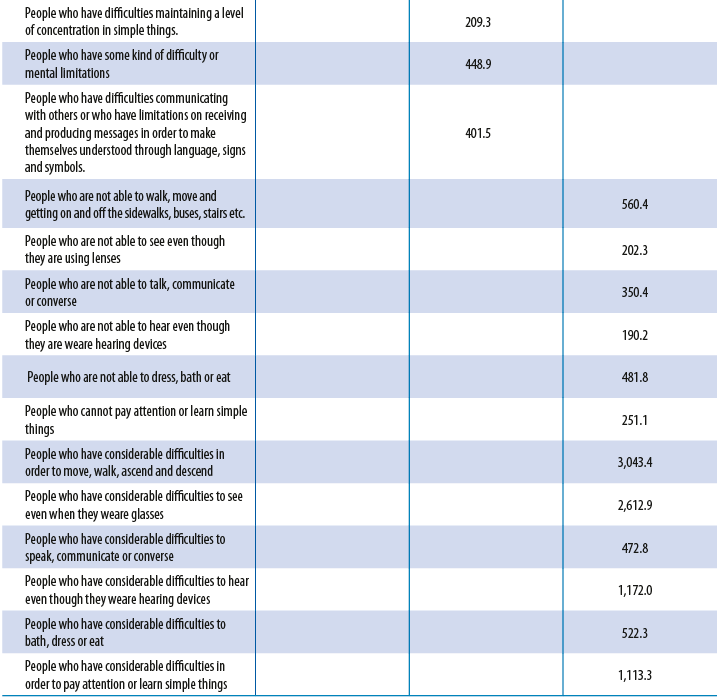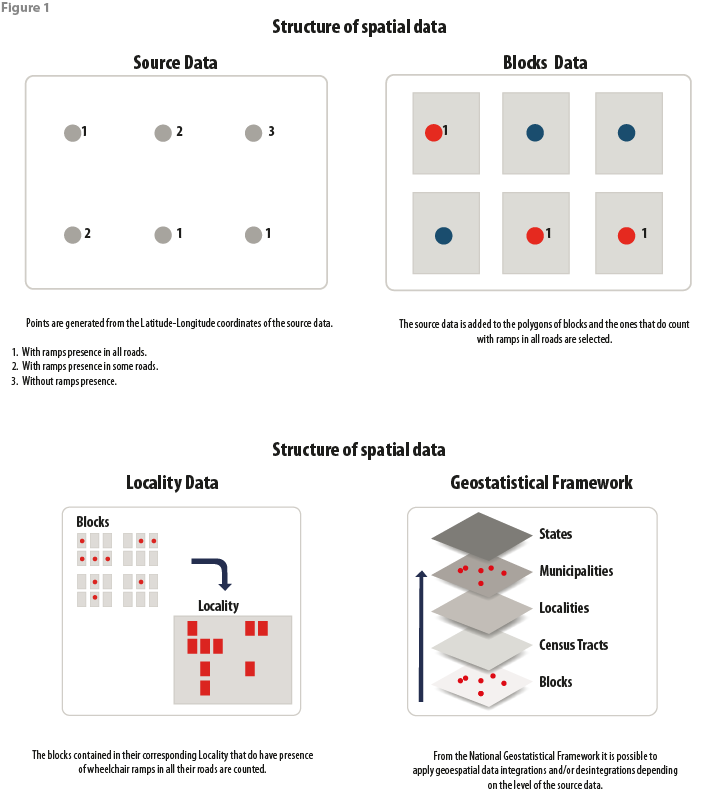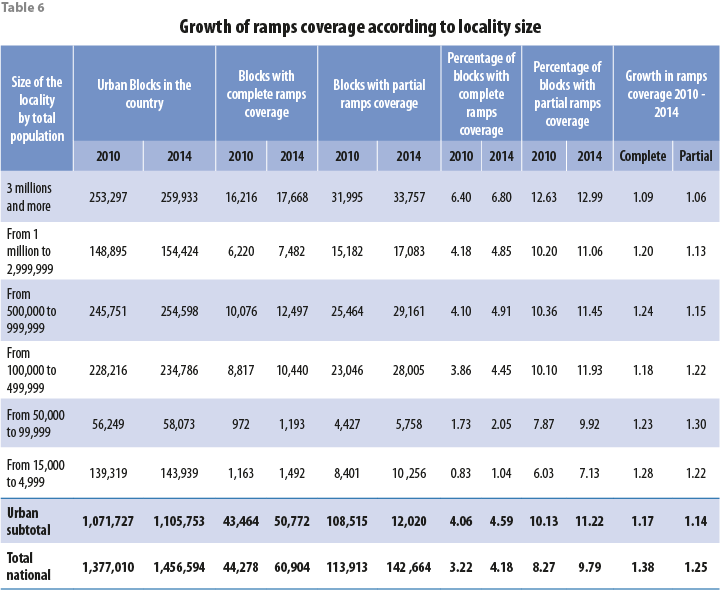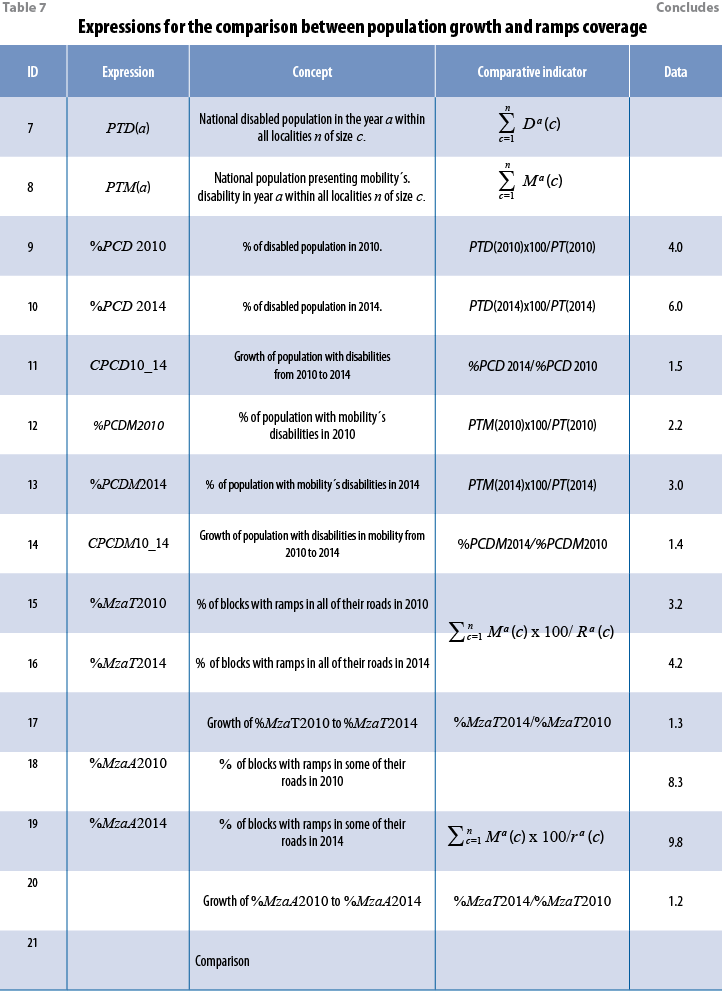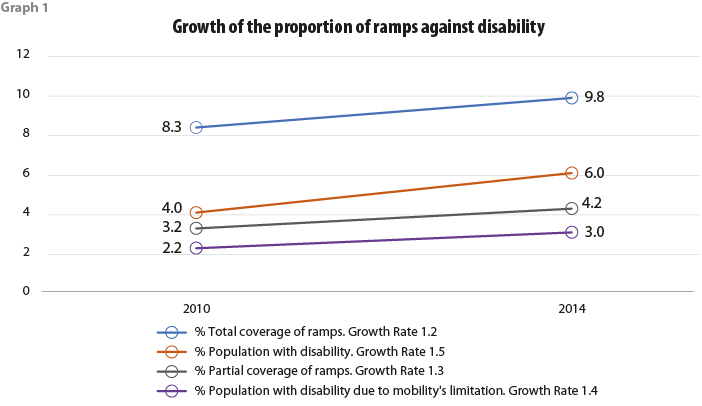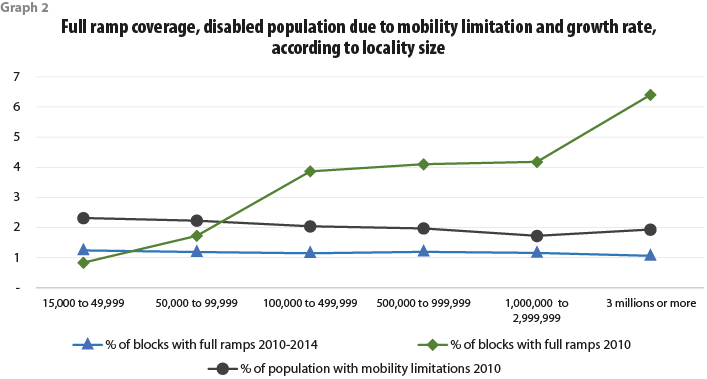The Dynamics of Disability due to Mobility Limitations and Ramp-Access Coverage
La dinámica de la discapacidad debida a las limitaciones de la movilidad y
cobertura de rampas de accesibilidad
Tonatiuh Suárez-Meaney, Professor of Universidad Autónoma del Estado de México.
Israel Albarrán Martínez, Special Project manager of Geoestrategias Electrónicas de Mercado, S.A. de C.V.
Verónica Pérez Barrón, Researcher of Hospital Psiquiátrico Infantil “Dr. Juan N. Navarro”.
Ioannis Chatziioannou, Instituto de Ingeniería, Universidad Nacional Autónoma de México.
Alejandro Martínez López, Actuary manager of bussines intelligence of Registro Único de Vivienda.
Luis Chías Becerril, Professor of Instituto de Geografía, Universidad Nacional Autónoma de México.
Corresponding author: Verónica Pérez Barrón, Peten 46-304, col. Narvarte, CP 03020, CDMX, demarcación territorial Benito Juárez. Telephone: 5523008122, veronicaperezbarron@gmail.com
Vol. 12, Núm. 1 – Epub The Dynamics of… – Epub
|
In this paper we seek to recognize whether the supply of disability ramps grows proportionally to the population that requires them. We compare the growth of the population with disabilities for mobility reasons in relation to the growth of ramps in terms of coverage within urban areas between 2010 and 2014 in Mexico. To carry out this comparison, it is necessary to discuss the volatility of the concept of disability due to its tendency to evolve steadily over the years, as it changed, even, in the study period making it very difficult to generate adequate measures that can provide useful geospatial comparisons. In this sense, the importance of tools such as the International Classification of Functioning, Disability and Health (ICF) of the World Health Organization to achieve appropriate and useful results is highlighted. The provision of ramps in urban areas in Mexico was taken from the National Institute of Statistics and Geography (INEGI), as an index of local government response to the disability problem. It should be noted that the aforementioned INEGI databases are useful to describe the real situation in terms of coverage of this infrastructure. The results allow us to observe that the population with mobility limitations is growing faster than the construction of ramps and that there is a need for actions to increase the speed of their provision in order to fulfill the purposes that the new vision of disability due to mobility limitations has generated. Keywords: geography of disability; census; ramps; mobility limitation; ICF.
|
En este trabajo buscamos reconocer si la oferta de rampas para discapacidad crece de forma proporcional a la población que las requiere. Se compara el crecimiento de la población con discapacidad por motivos de movilidad en relación con el de las rampas en términos de cobertura dentro de zonas urbanas entre el 2010 y 2014 en México. Para llevar a cabo este cotejo, es necesario discutir la volatilidad del concepto de discapacidad debido a su tendencia a evolucionar de manera constante a lo largo de los años, pues cambió, incluso, en el periodo de estudio haciendo muy difícil generar medidas adecuadas que puedan ofrecer comparaciones geoespaciales de utilidad. En este sentido, se destaca la importancia de herramientas como la Clasificación Internacional del Funcionamiento, la Discapacidad y la Salud (CIF) de la Organización Mundial de la Salud para lograr resultados apropiados y útiles. La provisión de rampas en áreas urbanas de México fue tomada del Instituto Nacional de Estadística y Geografía (INEGI), como índice de la respuesta del gobierno local al problema por discapacidad. Cabe destacar que las mencionadas bases de datos del INEGI son útiles para describir la situación real en términos de cobertura de esta infraestructura. Los resultados permiten observar que la población con limitaciones de movilidad crece más rápido que la construcción de rampas y que existe la necesidad de acciones para aumentar la velocidad de su provisión para cumplir con los propósitos que ha generado la nueva visión de discapacidad debido a limitaciones en la movilidad. Palabras clave: geografía de la discapacidad; censos; rampas; limitación en la movilidad; CIF. |
Recibido: 6 de mayo de 2019.
Aceptado: 10 de julio de 2020.
Introduction
The problem of disability is important because it is a factor of inequity against the families that face it. According to the micro-data published in ENIGH 2018 by INEGI, Mexican families are divided into two groups, those with at least one member facing disability and those without. It is observed that the former have on average less income, and while the proportion of their spending in housing and transportation it is very similar, the money spending for health by the people facing disability problems is much higher. This is just one example of how disability differentiates families. The modern concept of disability states that disability can pose serious problems in the realization of peoples everyday activities when the city’s environments intensify it. The establishment of environments that are able to simplify the life of people with disabilities, is capable to reduce the differences between disabled and non-disabled households, as well as the large economic difference between them. Nowadays, in terms of percentages there are 2.1% of households with disabilities in Mexico (Table 1).
Legal framework and urban equipment for disability
This paper compares the dynamics of the population with disabilities due to mobility limitations in Mexican cities, and the advancement in the coverage of ramps for disability (the ramps are so-called popularly, even though they have a wider use). The ramps nowadays, represent the main equipment for universal accessibility, which since the signing of the Convention about the Rights of People with Disabilities (1) are recognized in the laws of the Signatories, as mandatory implementation.
Mexican law seeks to “ensure accessibility in the basic infrastructure, equipment or urban environment and public spaces” as well as to promote the infrastructure for disability “to be universal, obligatory, progressive, signposted and adapted for all people”, both in urban and rural areas[1]. The Urban Development Act establishes that accessible spaces ensure free transit [2], and the actual regulations detail their minimum architectural characteristics in private centers [3]. Specifically, the legislation of Mexico City already considers the attention to mobility for people with disabilities as a top priority[4],[5]; for that reason, it obliges the architectural adaptation of the spaces [6], punishing those who do not respect them[7]. Thus, it is natural for the number of ramps to grow, but at the same time the user population grows as well, so it is necessary to measure the growth differential between the equipment designed for the mobility disabled population and the population with mobility disabilities, which is a complex concept.
Problem of definition of the disability concept and its evolution
Until 1900, following the juridical and global positivism of the time, the people with disabilities were not counted, they were even criminalized (2) (3), and referred with qualifiers such as blind, deaf, crazy and crippled. From 1950 to 2000, the disability “disappears” again from Mexican statistics.
Ledesma (4, P26) summarizes the modern vision of disability in four stages: a) Compassionate or Philanthropic stage; b) Rights recognition stage, since the 1950s disability is accepted as a “social problem”; c) Integration stage, between 1980 and 1990, people with disabilities are integrated actors in public decisions; d) Equality stage, since the present century, this stage seeks the visibility of people with disabilities, raising by that way the awareness about human rights.
On the other hand, Toboso and Arnau (5) consider the same number of stages but a different logic: Firstly, is the stage of disregard. Secondly, follows the stage of medical rehabilitation or care model, focused on the individual. Thirdly, is the Social Model stage, which is focused upon the surroundings of people with bases in the economic philosophy of Amaryta Sen (6), or the lowest income, closely related in Mexico to disability (7). Finally, follows the model of diversity that is still under development. Pantano (8) since 2003 was able to understand that the available statistics were taking measurements of different disability`s concepts, while Schkolnik (10) warned of the need to include in the census data questions such as the severity of disability. Until 2010 returns in Mexico the census quantification that allows the comparisons between different census populations. The evolution of the concept of disability is presented in table 2.
The ICF. Functioning, disability, and health
After numerous international studies and consultations, in 2001, the World Health Assembly approved the use of the International Classification of Functioning, Disability and Health (ICF) (15). The ICF contains a series of classifications in order to describe the person, his or her health and the states related to each individual. Thus, it is a tool that permits to describe the disability of the people by detailing their conditions, documenting in depth the possible deficiencies in their functions and corporal structures, as well as their limitations and restrictions in the activity and participation; in interaction with environmental and personal factors and the health (15, 16).
The new concept of disability within the censuses
The quantification of the population with disabilities faces problems that have been already identified by several authors (6, 8, 9), in order to achieve similar and indispensable data so that to evaluate equal-universal access. Table 3 shows that in Mexico from 1885 to 1940, the ancient concepts of disability are used. In addition (Table 4), even though the 1990s are the time of greatest change in universal adaptation due to technology and political activism (17). It is until the beginning of the new millennium, thanks to efforts such as the ICF, when the disability is recognized as a condition and not as a problem. In 2010, in Mexico, the censuses begin to record the levels of functioning and disability. In 2000, names that are more appropriate are given to disabilities, and in 2010 is added the origin of the disabilities, that is a very useful fact considered for the elderly. Moreover, in 2010 there are discussions about different level of limitations based upon the ICF that have as a result the perfection of measurements concerning the severity levels of disabilities in 2014.
Methodology
Based on the comparative concepts, it is sought to know within different localities in Mexico, at what speed the population with disabilities due to mobility limitations increases compared to the growth of the main urban access equipment such as the ramps.
Material
In this paper we were able to use different databases that can be appreciated in table 5, the above mentioned databases were very helpful in order to perform the following two measurements:
a. Evolution of the population with disabilities
In order to obtain the quantity of people with disabilities at a Census Tract (CT) as well as at a Municipality level, it was necessary to consult the data of the 2010 Population and Housing census (Censo de Población y Vivienda in Spanish). Moreover, through the census sample we were able to identify the cause of the disability for each of the individuals. For the year 2014 it was used the National Survey of Demographic Dynamics (Encuesta Nacional de la Dinámica Demográfica in Spanish) available by INEGI (See table 5 in order to consult the sources) and we made use of the expansion factors offered by the above-mentioned survey.
b. Evolution of the supply of ramps
We were able to measure the coverage of ramps for every block (and its centroid) through the public data of INEGI named “Infraestructura y características del entorno urbano” (2010 y 2014) (See table 6), where each block can be evaluated and qualified according to the ramps availability that offers to the people via the surrounding roads. Every block can be qualified with the following five possible numerical indicators: 1) “all the surrounding roads have ramps” (total coverage), 2) “some of the surrounding roads have ramps” (partial coverage), 3) “none of the surrounding roads have ramps”, 4) “housing complex”, 5) “No specified”. For this work we took under consideration only the blocks with values equal to “1”, “2” or “3” because the blocks with values equal to “4” and “5” are very peculiar and they present a very small part of the sample. In figure 1 can be seen the qualification procedure, as well as the geo-informatics process that needs to be followed within a Geographic Information System. In table 6 can be appreciated the growth in ramps coverage according to the localities size growth in terms of total population.
Method
In order to obtain the previously mentioned measurements a) and b), it is necessary to analyze changes both in time and space with the following variables:
α, year. α1 year 2010 or α2 year 2014.
Ta (c), total population in the year within localities of size c.
Da (c), population with some kind of limitation in the year α within localities of size c.
Ma (c), population with mobility´s limitation in the year α within localities of size c.
Ba (c), total number of blocks in the year α, within localities of size c.
Ra (c), blocks with total coverage of ramps in the year α within localities of size c.
ra (c), blocks with partial coverage of ramps in the year α within localities of size c.
The growth of ramp coverage (expression 16 and 20 of table 7) and the relative population growth to mobility limitation (expression 11 and 14 of table 7) were estimated for all the localities.
We were able to calculate the population´s proportion with some kind of limitation according to the size of locality via the expressions 1-9 seen in the table 7. The total national population is equal to the population of all the localities of all sizes as indicated in expression 6 of table 7. The sum of the population with disabilities due to some kind of limitation within all localities, is the population with disabilities at a national level, while the sum of population with disabilities in terms of mobility limitation within all localities is the national representation of mobility´s disability. These are our national disability indicators. The principal indicators that need to be calculated can be seen in the expressions 9-20 of the table 7.
When the population within a geographic entity grows, it is expected to grow the special groups of population as well (for example the disabled population). So if α2 > α1 (2014>2010), it would be expected that relations of all kinds of population for the two periods would grow, that is to say: CPC>1, CPD>1 y CPDM>1. However, if we take into consideration proportions, and if the social and integrative model of the disability were fulfilled in accordance with the ICF canons, it would be expected that the proportion of the disabled population would decline, that is to say,
Also a social model of disability carried out in the different local governments, could suppose that the infrastructure in general for the disabled people, and in particular the ramps would increase each year in a greater proportion than that of the population with disability in order to cover the objective of 100% universal access. That is to say, the CMCR>1 and CCR>1. Each local government would be initiating the urbanization of new blocks, trying to achieve complete coverage of ramps in neighborhoods that had partial coverage. In Mexico, we see that in the year 2000, 45% of the population with some kind of disabilities was reported. In 2010, this percentage raised as a 53% of the population with limitations in walking, moving, getting off and on public transportation modes was registered. Finally, in 2014, we are able to see that 50% of the population with some kind of disability was reported. As we can see the statistics is not comparable, but it oscillates between 45% and 53% of the mobility´s limitation and also it oscillates between 4% and 6% of the population´s total disability.
Change in time
The graph 1 shows the data of table 8. The growth rates of the disabled population ratios are higher than the growth rates of ramp´s coverage. In other words, the population with disabilities is growing faster than the coverage of ramps.
In general it can be noted that the coverage of ramps increase. The growth rate of partial ramps coverage though, is higher than that of total coverage. Which seems to indicate something that is usually seen on the streets, where the local governments who are in charge of establishing ramps coverage, implement their lines of action according to their budgets, although it is known that partial coverage is not completely useful because if a wheelchair goes up at one point of the block, it is understood that it will have the opportunity to go down at another. This may involve working in parallel instead of following a sequential approach, that is, moving forward in many blocks at the same time instead of starting when only having completed the previous one. However, it is obvious, that the population with disabilities due to mobility grows faster than the coverage of ramps.
Change in space
In graph 2 which shows the data of table 9, we can see how there is a tendency for the larger localities to have a lower proportion of population with disabilities due to mobility´s limitation (by the year 2010). Maybe, this tendency can be justified because there are more health services or more prevention in these larger localities. It may also be due to the fact that the adjustments made by large cities allow people with different conditions to adapt to various activities. Moreover, through graph 2 we are able to see that the larger localities not only have fewer people with disabilities but more coverage of ramps infrastructure. This may be because in large cities there are more health services, greater access to education and greater possibilities for transportation.
The following graph shows how in larger cities there is more complete coverage of ramps, and at the same time, a smaller population with disabilities, even though the growth of the latter is almost constant in all city sizes.
Discusion
Urbanization-Metropolisation is currently one of the most important phenomena of the 21st century because concentrates a great number of people to urban centers in order to find better life opportunities. Nevertheless, urban environments, infrastructures, facilities and services, depending how they are planned and built, can impede or enable access, participation and inclusion of members of society (18).
Since the late 1980s it was known that a metropolis accessible to everyone did not have to be a utopia (19).
There is evidence in literature, revealing a widespread lack of accessibility in built environments, from roads and housing, to public buildings and spaces. Evidence also reveals a lack of accessibility to basic urban services such as sanitation and water, health, education, transportation, emergency and disaster response, resilience building, and access to information and communications. These accessibility limitations greatly contribute to the disadvantages and marginalization faced by persons with disabilities, leading to disproportionate rates of poverty, deprivation and exclusion (18).
However, major cities show greater attention to disability, due to their medical services and the level of accessibility to different services that they offer to their inhabitants, so there is less disability, but they also have more ramps coverage. Which would explain why people with disabilities from other localities come to them for treatment and if their income allows it, to live in them so that to find better accessibility conditions, not only due to the greater number of ramps, but also due to the possibilities offered by some public transport services, greater employment possibilities, access to health and educational facilities. Considering the current concept, the disability should not only be registered in terms of absolute numbers, but also in terms of severity, and whether it is experienced within a favorable environment or not. If the smaller cities do not offer universal access, they can expel disabled people, as well as, people belonging to priority care groups (elderly, pregnant women and people with strollers) and enter into a vicious circle: there are no ramps because there is no population that needs them.
The unfavorable disproportion that results comparing the growth speed of ramps coverage with the count of the number of people who have mobility´s limitation is barely studied. Most countries do not even count their ramps, making it more difficult to diagnose barriers related to disability. Efficient ways to generate geo-spatial knowledge through well-established governmental inventories should be found that can help to assess the mobility of disabled people. Moreover, this kind of geo-spatial mechanisms should be enriched via information related to ramps quality, such as ramps slope, ramps width and ramps direction in order to secure that the ramps will be user friendly. Furthermore, it should be highlighted that ramps coverage is only one element required to improve universal accessibility and is one of the easiest and perhaps least expensive to solve. On the other hand, generating public transport services, or having specialized health services, lifts and escalators is more complicated and expensive.
It is worth mentioning, that in the disability scenario, multiple complex relationships are registered between the limitations of people and the physical and socio-economic barriers that exist in the environmental context, including economic supports, jobs, access to education and personal situations. Hence, it is not surprising, to discover the inverse relationship between the number of ramps and the population with disabilities due to limitations in mobility.
Conclusions
Although the issue of disability is not new in the world, in Mexico it has statistically recovered since 2010, reflecting the little attention it has received officially and socially. The lack of ramp equipment and its below demand growth, precisely expresses the little attention given to the issue of disability in Mexico. The latter requires not only certain infrastructures such as ramps, but changes of perspective (social interventions and public policy) that propose and generate comprehensive and inclusive solutions. The concept of “smart cities” represents for countries like Mexico an utopia, for that reason, urban planners, sociologists, engineers, geographers and other specialists must work on the design and functionality of “inclusive cities” that allow universal accessibility for children, older adults, women, pedestrians and of course people with disabilities.
Considering these facts, the objective of this paper has been to recognize whether the supply of ramps equipment grows in a similar way as the population that requires it.
The importance of comparing the infrastructure for disability with the dynamics of the disabled population is that the programs and resources allocated and promoted by the government should be evaluated via objective data and information, so that to recognize whether the rights of people with disabilities are being recognized.
The soundest part of this investigation is the creation of a methodology that through the application of a series of indicators allows us to recognize if the supply of ramps really improves.
The summary of our findings is very interesting because it shows that the lack of equipment such as ramps and their growth rate that is below the demand, requires actions that will permit the increase in the speed of ramps allocation in order to meet the purposes that have been generated by the new vision of disability by mobility´s limitations.
Nevertheless, it is worth mentioning that the above mentioned methodology has some limitations, for instance, the fact that there is ramp coverage does not tell us anything about the appropriate quality of these ramps. In addition, there are blocks with very complex shapes that are not well surveyed by counting how many of their sides are covered by ramps. Moreover, there are very large blocks that may have a covered side by ramp but only in a small proportion, resulting by that way, insufficient the coverage of infrastructure.
In Mexico the INEGI has undertaken the task of counting and registering the characteristics related to urban environment, but not in all the countries can be seen this type of data collection, thus the methodology will not be easily applied in many other countries.
It is essential in an issue as important as disability that governments measure progress based on the infrastructure’s quality and quantity destined to this condition. Therefore, measuring accessibility is an important task. Global efforts have already been made to classify disability, but we still do not know whether the city’s environment is suitable. Thus, it can be measured within the urban space where and how destinations are dispersed (20).
To measure the city’s environment accessibility, the local and regional scales must be considered. Within the latter it is important to take into account, the structure of travels origins and destinations, urban morphology, urban equipment (including ramps, sidewalks, etc.) and locally architecture. All these elements must form a system to measure the accessibility of the city’s environment.
For the near future, a set of similar evaluations like the ones presented in this investigation can be carried out periodically in order to recognize which places have advanced more in the supply of universal spaces and which ones need to be helped.
____________________
References
- Asamblea General-Naciones Unidas [Internet]. Convención sobre los Derechos de las Personas con Discapacidad, protocolo facultativo; 2006 [cited on 12 june 2020]. Retrieved from https://bit.ly/3eD2nFq
- Schweik SM. The Ugly Laws: Disability in Public (The History of Disability). New York: University Press; 2010.
- Da Silva Bampi LN, Guillhem D, Dornelles Alves E. Social model: a new approach of the disability theme. Rev Latino-Am Enferm. [Internet].2010 [cited on 5 jun 2020]; 18(4):1–9. Retrieved from https://bit.ly/3aFEICY
- Ledesma JA (editor). La imagen social de las personas con discapacidad. Estudios en homenaje a José Julián Barriga Bravo [Internet]. España: Comité Español de Representantes de Personas con Discapacidad. Ediciones Cinca. Fundación Academia Europea de Yuste; 2009. [cited on 28 may 2020]. Retrieved from https://bit.ly/3u2WyaI
- Toboso Martín M, Arnau Ripollés MS. La discapacidad dentro del enfoque de capacidades y funcionamientos de Amartya Sen. Araucaria, Rev Iberoam Filos Política y Humanidades [Internet]. 2008 [cited on 6 jun 2020]; 10(20):64-94. Retrieved from https://bit.ly/2QzsJzW ISSN 1575-6823
- Martínez Ríos B. Pobreza, discapacidad y derechos humanos. Rev Española Discapac [Internet]. 2013;1(1):9-32. Retrieved from https://bit.ly/3vgf0Nk
- Chías Becerril L, Pérez Barrón V, Suarez Meaney T, Albarrán Martínez I. Edad discapacidad y movilidad. Revista Accesos [Internet]. 2014;5(30):10-12. Retrieved from https://bit.ly/3npHcKS
- Pantano L. La medición de la discapacidad en Latinoamérica: los marcos conceptuales de preguntas censales. Lecciones de algunas experiencias. Boletín del real Patronato sobre Discapacidad [Internet]. 2003 [cited on 5 jun 2020]; 56. Retrieved from https://bit.ly/3u2Xfkk
- Schkolnik S. América Latina: la medición de la discapacidad a partir de los censos y fuentes alternativas. Notas de Población CEPAL. 2011; 37(92): 275-306.
- Stiker HJ. A history of disability. Series Corporalities: Discourses of Disability. Michigan: The University of Michigan Press; 1999.
- Rose M. The staff of Oedipus. Transforming disability ancient Greece. Michigan: The University of Michigan Press; 2003.
- Trompoukis C, Kourkoutas D. Greek mythology: the eye, ophthalmology, eye disease, and blindness. Can J Ophthalmol Can … [Internet]. 2007;42(4):562–6. Retrieved from https://bit.ly/3tYtpgU
- Metzler I. A social history of disability in the middle ages. New York: Routledge. Taylor And Francis Group; 2013.
- Pérez de Plá E. Sujeto, inclusión y diferencia: Investigación psicoanalítica y psicosocial sobre el Síndrome de Down y otros problemas del desarrollo. Ciudad de México: Universidad Autónoma Metropolitana Unidad Xochimilco; 2000.
- Organización Mundial de la Salud. Clasificación Internacional del Funcionamiento, de la Discapacidad y de la Salud. España: Publicaciones la Organización Mundial de la Salud. 2001;1–288.
- Verhoef J, Toussaint PJ, Zwetsloot-Schonk JHM, Breedveld FC, Putter H, Vliet Vlieland TPM. Effectiveness of the introduction of an international classification of functioning, Disability and health-Based rehabilitation tool in multidisciplinary team care in patients with rheumatoid arthritis. Arthritis And Rheum [Internet]. 2007; 57(2):204-8.
- Shapiro J. No Pity. People with disabilities forging a new civil rights movement. New York: Three Rivers Press; 1994.
- United Nations [Internet]. Enhancing the accessibility of information and technology and inclusive development. Convention on the Rights of Persons with Disabilities. 29 March 2016 [cited on 12 June 2020]. Retrieved from https://bit.ly/3npbBcn
- Hahn H. Disability and the urban environment: a perspective on Los Angeles. Environment and Planning D: Society and Space. 1986;4(3): 273-288.
- Church RL, Marston JR. Measuring accessibility for people with a disability. Geographical Analysis. 2003;35(1), 83-96.
[1] Ley General para la Inclusión de las Personas con Discapacidad. Artículo 16. Diario Oficial de la Federación 30/05/2011. México. https://bit.ly/3sgGTTy
[2] Ley General de Asentamientos Humanos, Ordenamiento Territorial y Desarrollo Urbano. Diario Oficial de la Federación. 28/11/2016. México https://bit.ly/3ghRWcG
[3] Norma Oficial Mexicana Nom-034-Stps-2016, Condiciones de Seguridad para el Acceso y Desarrollo de Actividades de Trabajadores con Discapacidad en los Centros de Trabajo. 20/07/2016 México. Diario Oficial de la Federación. https://bit.ly/2Q5khbz
[4] Ley de Movilidad del Distrito Federal Artículo 6. Asamblea Legislativa del Distrito Federal. Consultado el 03 de mayo de 2021. https://bit.ly/3eicCjv
[5] Ley para la Integración al Desarrollo de las Personas con Discapacidad del Distrito Federal, Artículo 9. Asamblea Legislativa del Distrito Federal. Consultado el 03 de mayo de 2021. https://bit.ly/3efJNUP
[6] Ley de Salud del Distrito Federal. Artículo 86-VI. Asamblea Legislativa del Distrito Federal. Consultado el 03 de mayo de 2021. https://bit.ly/33hbmGQ
[7] Ley de Desarrollo Urbano del Distrito Federal. Artículo 99-III. Asamblea Legislativa del Distrito Federal. Consultado el 03 de 20 de mayo 2021. https://bit.ly/2RqcWn4


